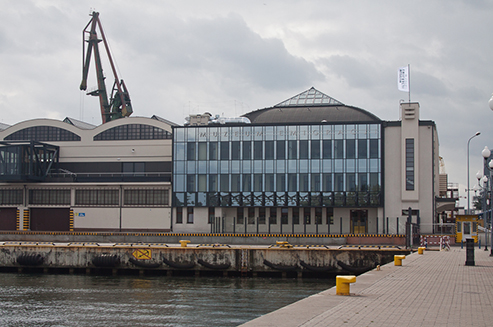Construction works in the historical Marine Station, whose harmonious building has become an element of Gdynia’s landscape after 70 years, are completed. This most representative edifice in Gdynia, which in the 1930s was the symbol of a country deserving to have its rightful place on the Baltic Coast, has not only been renovated but also modernised to meet the needs of a modern and multifunctional institution of culture. Its final stage, the permanent display, is just to begin. In the first half of 2015 the only Emigration Museum in Poland will open under a very significant address: Gdynia, 1 Polska Street.
When the 292-metre-long MSC Orchestra cruise ship was entering the Gdynia harbour located next to the Marine Station, Professor Małgorzata Omilanowska, the Minister of Culture and National Heritage, Wojciech Szczurek, President of Gdynia, and Karolina Grabowicz-Matyjas, Director of the Emigration Museum, presented the fresh and new interiors of this renovated building to the invited guests and journalists for the first time. Although the building is still closed to the public, it has already changed the landscape of the waterfront, where the biggest cruise ships in the world moor today. Since the very beginning the construction was connected with traveling – the Marine Station, built in 1933, served the emigration traffic for years and it was here that hundreds of thousands of people started their journey. This is where many national and international routes met and where legendary Polish ocean liners, including MS Batory, anchored. Gdynia’s emigration history, harbour location and the monumental Marine Station building create a perfect frame for the institution that aims at giving the history of Polish emigration the right place in the collective memory.
During the war the Marine Station was seriously damaged. The bombs destroyed the northwest part of the building. For the next 70 years the scar, its characteristic asymmetry, was clearly visible. After the war the Marine Station regained its previous role but the passenger traffic didn’t have the old dynamics any more. The end of a certain era came in 1988 when MS Batory set off on its last voyage. Two years later the building was registered as a national monument.
Renovation and modernisation works in the Marine Station and the adjacent Transit Warehouse started in May 2013 and they were conducted according to the project by ae fusion Studio from Kraków. According to this project, the building was to be rebuilt on the basis of the plans from 1933, including the missing northwest corner, and the historical building was to be adopted to play its completely new role. The waterfront exterior was changed – the brick wall was replaced by a glass panel, which gave this 80-year-old building a modern and lighter look. A steel construction of an original view point – a glass tunnel starting at the Transit Warehouse – was also erected. The bridge is an architectonical and symbolic reference to the historical gangplank that people leaving the station used to get aboard. Dialogue with the past is also conducted through the restoration of the original Polish symbols on the exterior as well as inside the building. For example, the façade has been decorated with the reliefs representing Polish eagles, removed during the war.
Restoration works, overseen by the Regional Historic Preservation Officer, also included reconstruction and revalorisation of all the details according to their original design. These included wooden doors, railings, wall lights, floor tiles and skylights, which decorate this icon of Gdynia modernism in a special way. The deadline was a huge challenge. The task was not only to rebuild a historical property but also prepare the advanced technical infrastructure for a multimedia exhibition. In order to provide the museum with the proper display conditions, special exhibition-dedicated architecture was applied inside the Transit Warehouse. Now it is ready, a tender has been announced to select the company to prepare the exhibition itself. Its completing, planned for the first half of 2015, will enable opening the Emigration Museum in Gdynia to the public.
More information on: the Emigration Museum in Gdynia
Photos © Anna Karahan


